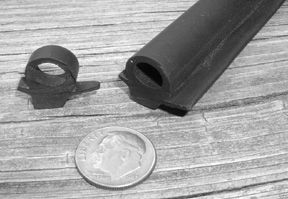
Like a lot of sailors, we abhor leaks down below. This attitude was developed in part through time spent rebedding portholes, deck fittings, and wood trim. But it truly took shape when a succession of seas broke over the cabintop on a recent passage. On that occasion, water poured right onto the heads of the slumbering off-watch. Yikes! The culprit turned out to be the hardened, cracked, and permanently compressed weatherstripping on the cabin hatches. Fixing leaks like these shouldn’t be much of a problem, except when you’ve got an older boat, which made it difficult for us to find a replacement gasket for the hatch that was identical to the existing gaskets.
Our search for proper gaskets turned up a tremendous number of styles, but none that matched the application on our boat. Yes, we could have gone with some generic rubber weatherstripping from a “hardware” box-store, but we wanted the real stuff that fit into the grooved channels on the cabintop so that we’d have a proper seal.
Lots of time spent on the Internet searching, and lots of phone calls to would-be suppliers convinced us that we would never find an existing identical replacement. However, we did turn up an outfit in California that could custom-manufacture the gasketing.
Jerry Belsha runs A Glass Act in Long Beach, CA. Talking with him was fascinating—he has almost 5,000 custom dies for extruding rubber products; roughly 4,000 of them are specifically for boats. Belsha can extrude gaskets using either a custom die or an existing die from his vast catalog. For our boat, he told us, he would have to make a custom die. For the best reproduction accuracy, Belsha didn’t want to use our scaled photo nor a fax, instead he wanted a slice of the original gasket. So, we sent him a cutting of our old gasket and a check for $150 to cover the die fabrication cost. In a couple of weeks we received a letter from Belsha with a small sample of our newly extruded gasket. The sample was meant to be used for a test fit, and to compare the new extrusion to the old one.
The new extrusion looked good. We noticed that it was a little bit bigger than the sample that we had sent, plus there were two small burr marks inside the round tube portion of the extrusion. We called Belsha to ask about this. He told us that he purposely makes the extrusions a little over-sized to account for age-related shrinkage of the original gasket. The burr marks, he said, were from burrs on the die, and they’d be easy for him to remove.
The gasketing Belsha extruded was easy to work with. It’s made of EPDM (Ethylene Propylene Diene Monomer, a rubber material whose principal components consist of the compounds ethylene and propylene) and boasts a hardness of 80A to 90A. After measuring and cutting lengths for each side of the hatch, we mitered the corners and used cyanoacrylate glue (e.g., Super Glue) to seam the corners together. Belsha recommends using 3M Super Weatherstrip Adhesive. (He also says it’s important not to stretch the gasket when you measure it, because it will shrink as it ages.) Because we’re familiar with this product and how it cures, we used Dow Corning 795 Silicone Building Sealant for adhering the extrusion to the hatch.
The procurement process was easy, too. We did have one problem with the extrusion oversizing. The extrusion sits in a channel. Two of our hatches have fiberglass channels and one has a wood channel. The rubber part that sat in the fiberglass channel was a little too wide. A quick pass with the Dremel tool on the fiberglass opened the channel just enough to ameliorate the issue. The wood channel with its straight sides needed no modification.
Belsha says that 90 percent of the gaskets he sells are black, but the material can also be extruded in white or gray. The total cost incurred was $150 for the die and $4.50/ft. for the gasketing. It looks good, fits well, and compresses nicely. This is, of course, much more expensive than the store-bought closed-cell foam gasketing that you might find at hardware stores, which sells for roughly 40 cents/ft. But, if you want that original-type seal and don’t like the glue giving out on the store-bought weatherstripping, then custom gaskets from A Glass Act might be the answer—especially if your boat uses one of those 4,000 dies that Jerry Belsha has in stock.
Contact – A Glass Act, 888/432-4312, (no web site available)
































